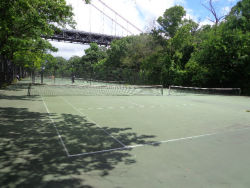Fort Washington Park
American Redout Monument
What was here before?
Prior to European settlement, the Lenape plied the turbulent waters of the North (Hudson) River shallows, and this promontory was a verdant bluff facing the rugged cliffs of New Jersey’s Palisades. During the American Revolution, Colonial forces built a battlement here to reinforce the strategic position of nearby Fort Washington. It was designed by Antoine Felix Imbert, a young French engineer who volunteered for the American cause. The protective earthwork fortification known as a redoubt (spelled in the monument’s archaic inscription as “redout”) was set within the riverfront hillside and built by Malcolm’s Corps, a Scottish unit in the Continental Army that included Lt. Colonel Aaron Burr. Later, the steep embankment and wooded bluff was a popular scenic overlook and picnic grove prior to the construction of the George Washington Bridge in 1931.
How was this created?
The monument was commissioned by the Fort Washington Chapter of the Daughters of the American Revolution and consists of a three-ton natural boulder succinctly inscribed with a testimonial to the redoubt and set on a bed of smaller stones. It was designed by Reginald Pelham Bolton (1856-1942), an eminent local engineer, archaeologist, and historian, who served as vice president of the American Scenic and Historic Preservation Society and City History Club of New York City.
With considerable fanfare and pageantry, the monument was dedicated on November 16, 1910, marking the 134th anniversary of the surrender of Ft. Washington to the British. A large contingent of dignitaries, members of the DAR and 500 troops from the Coast Artillery convened first at the Chapel of the Intercession of Trinity Church and then paraded to the monument, where the monument, draped by an American flag, was unveiled by 18 children -- “the Little Men and Women” of the DAR’s Ft. Washington Chapter.
Emily Fay, DAR chapter regent, described the monument “on this eminence as a sentinel to guard this park from desecration” and called attention to its advantageous position in which “the stately Palisades make a beautiful backdrop.” Parks Commissioner Charles Stover spoke of the park being “safe” from encroachments, commenting—erroneously as it turned out—that he did not expect that the bridge to New Jersey would ever be built, and anticipated that the nearby New York Central Railroad tracks would be decked over. Alas, the first came to pass and the second did not, later rendering the site remote, noisy and inhospitable. Today, only the most intrepid park visitors may make their way to this vestige of an earlier era and location of considerable historical significance.
What does this monument commemorate?
This monument honors the historic fortification at this site (vestiges which remain) and the heroism of the rebel battalion of soldiers who fought here under the command of Col. Robert Magaw (1738-1790) of the Continental Army. Its sponsors described its intent as not commemorating “a victory or a defeat…but to honor and show respect to those who, in the darkest days of the Revolution, fought so willingly and so valiantly for that which we now all enjoy—freedom…on that sacred ground.”
Check out your park's Vital Signs
Clean & Safe
Green & Resilient
Empowered & Engaged Users
Share your feedback or learn more about how this park is part of a
Vital Park System

Know Before You Go










